
 |
Eager Space | Videos by Alpha | Videos by Date | All Video Text | Support | Community | About |
|---|

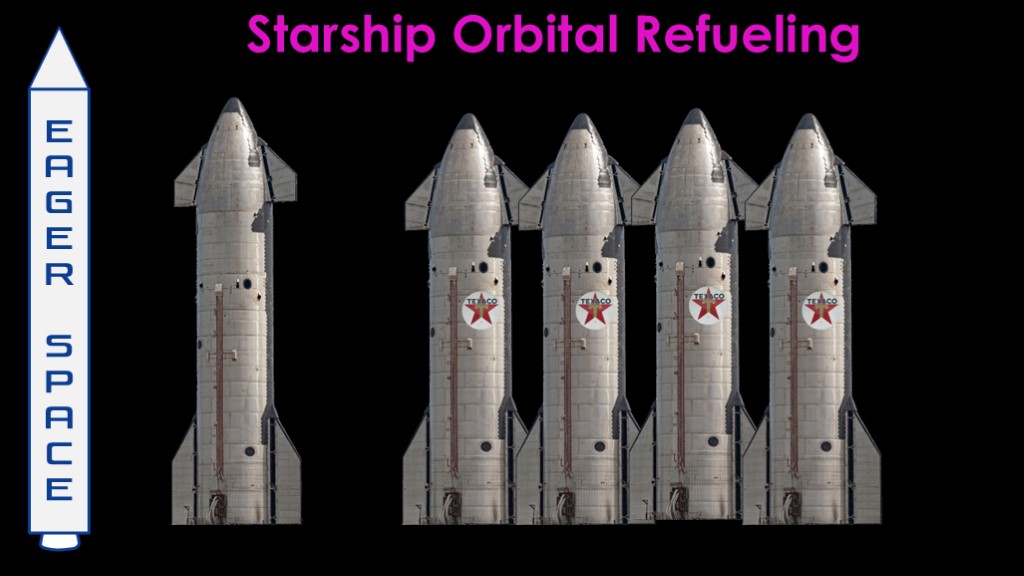
Artemis Lunar Architecture: https://www.youtube.com/watch?v=O2IBV_XSu60
Starship Orbital Propellant Depot: https://www.youtube.com/watch?v=fjWCEFioT_Y
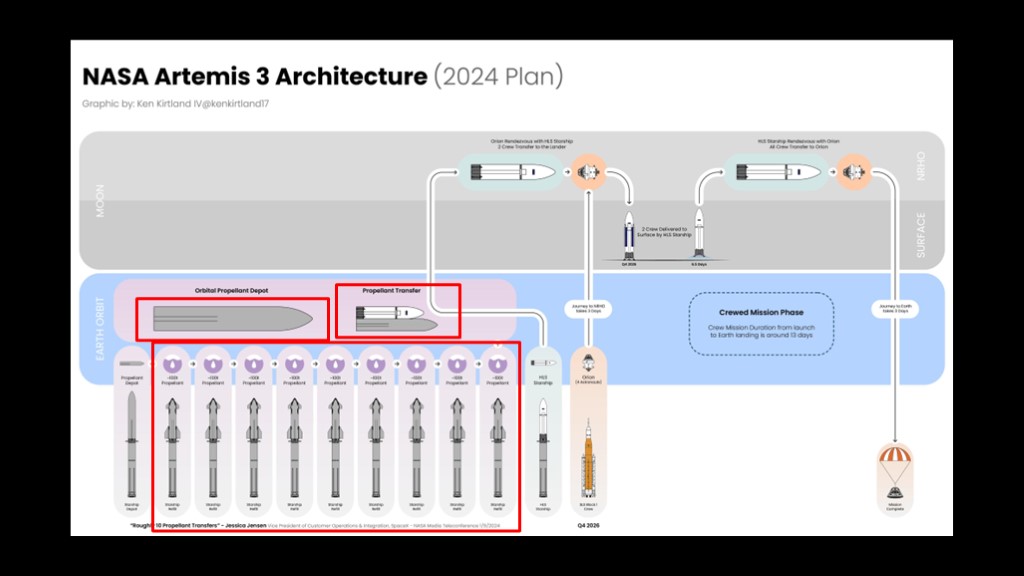
Many of you already know the planned architecture for NASA's artemis moon missions.
SpaceX will launch a starship orbital propellant depot into low earth orbit, then fly a number of tanker flights to fill up that depot. A HLS lunar starship will be launched, refuel from the propellant depot, then proceed to lunar orbit to pick up astronauts from the orion capsule sent there by SLS, land on the surface, and then return to orbit to transfer the astronauts back to the Orion so they can return to earth.
You may look at this diagram and say, "that looks complex and risky".
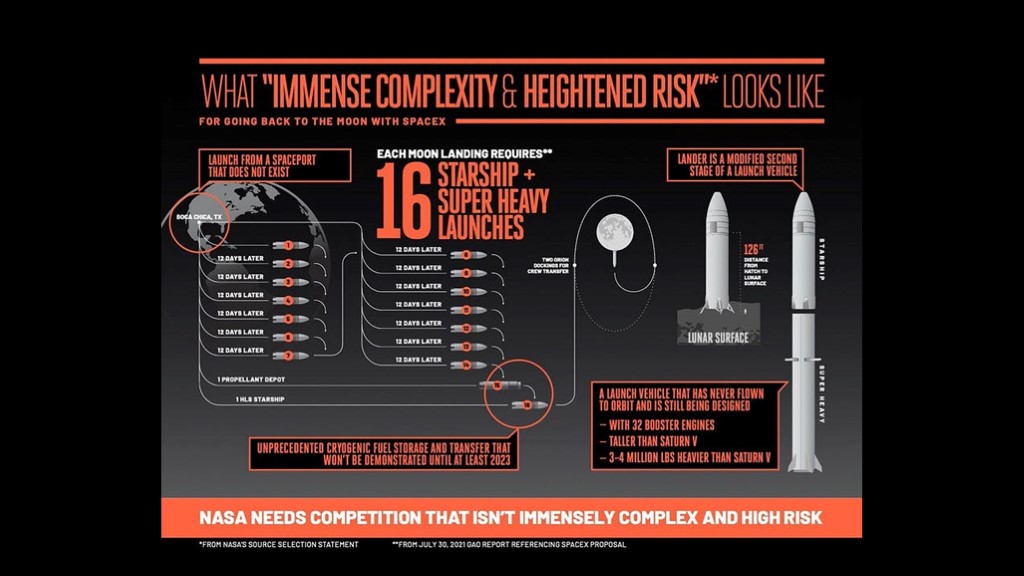
And that, in fact, was what the National Team - headed by Blue Origin - asserted in this infographic in response to their loss of the HLS contract to SpaceX.
The first question to answer is "why did SpaceX choose this architecture?".

The long story is in my video on the artemis lunar architecture, which I've linked in the video description.
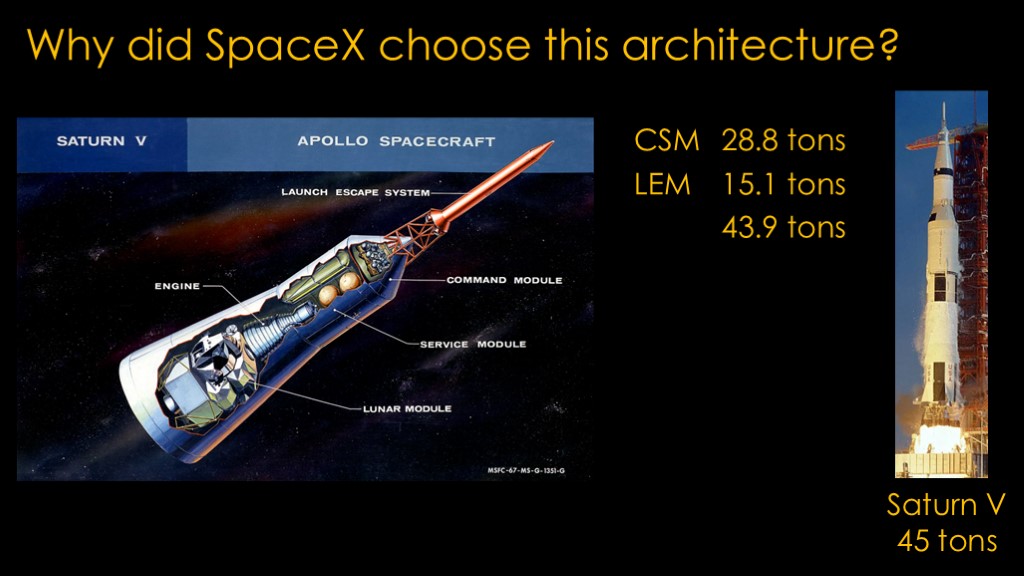
We need to look back at Apollo. Apollo had a very simple architecture - the apollo spacecraft included the command module that held the astronauts, the service module which held propulsion and the supplies to keep the astronauts alive, and the lunar module that would go to the moon's surface and back into lunar orbit.
For apollo 11, the command and service module massed 28.8 tons and the LEM added 15.1 tons, for a total mass of 43.9 tons.
The Saturn V used for Apollo 11 could send about 45 tons on a trans-lunar injection trajectory, so it was powerful enough to get the apollo spacecraft there.
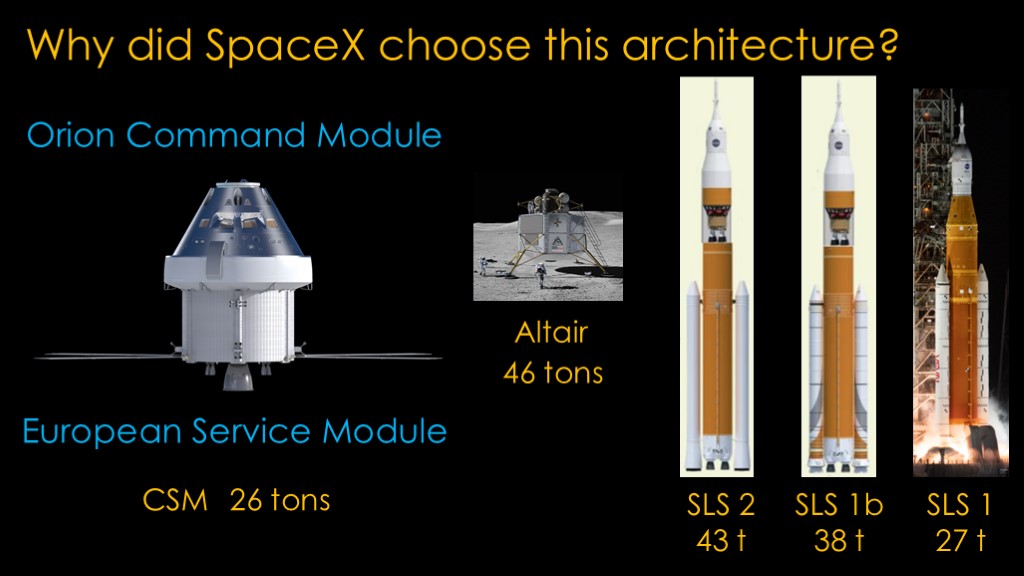
The Artemis architecture is similar, but different in a very important way.
There is an orion command module, a service module made by the European space agency, and... that is it. Their total mass is about 26 tons.
The SLS block 1 that will be used to launch Artemis III - the first mission to the surface of the moon - can send 27 tons to trans lunar injection, and that seems fine.
The problem, of course, is that there's no lunar lander in this architecture. There was one known as Altair in the previous constellation architecture - a big one at 46 tons - but Congress told NASA to build the SLS rocket and Orion capsule and gave them money for that, but they didn't include a lander or money to build one.
There are bigger versions of SLS - the SLS block 1b has a higher-powered upper stage and it can send 38 tons to the moon, and the mighty SLS block 2 can do 43 tons. So you could fly a 17 ton lander - if you had one - on the block 2, but that actually wouldn't work because the Orion service module can barely get Orion into a lunar orbit and back out again, and it doesn't have the margin to also put a lander into lunar orbit.
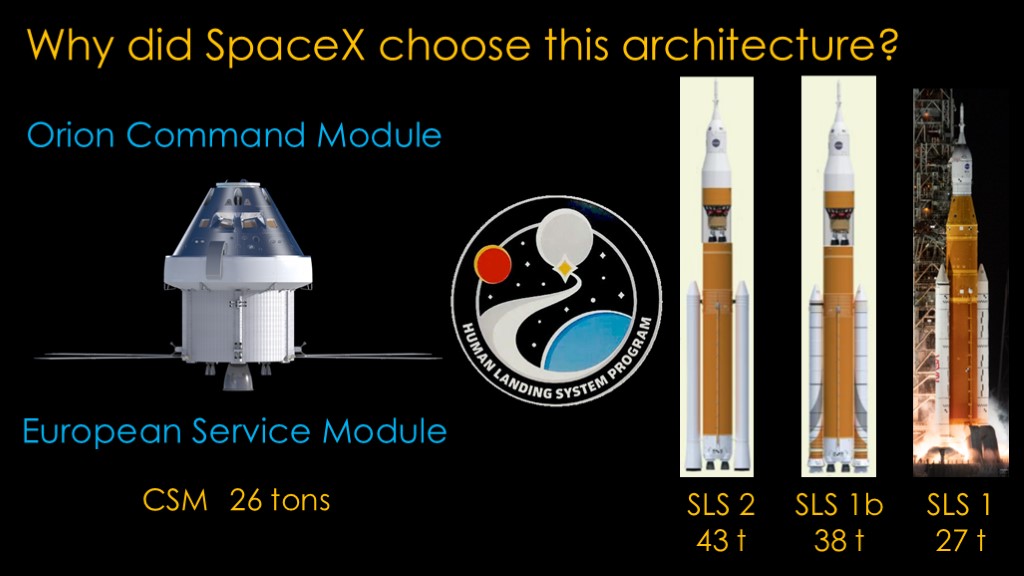
NASA has a big problem. They have this "mega moon rocket" but it's only good for sightseeing to lunar orbit and they have no solution to get down to the surface.
They decided to do what we would all like to do - make it somebody else's problem. SLS would deliver orion to a lunar orbit, and somebody else would be on the hook to get the lander there. And the Human Landing System program was born.
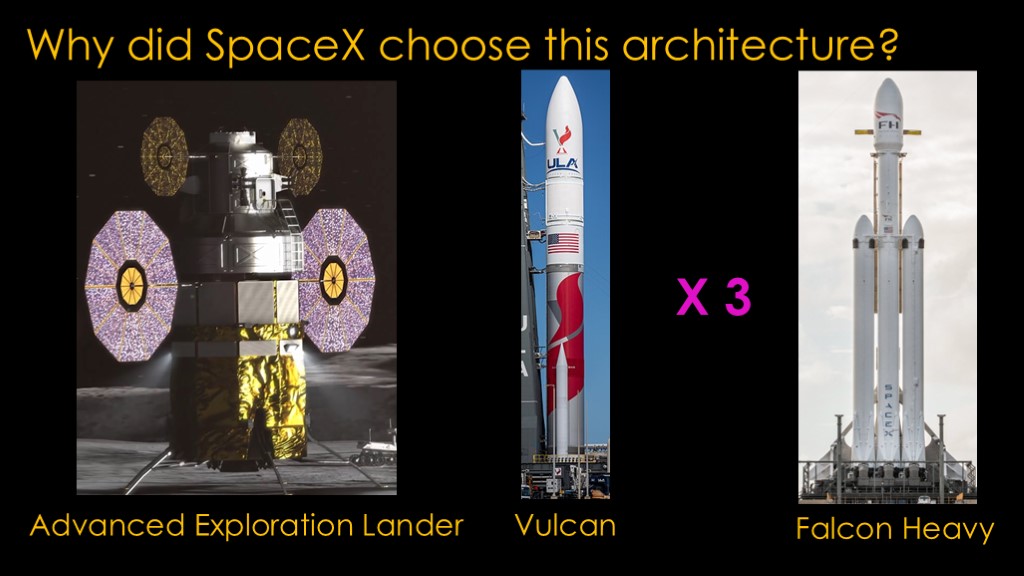
NASA came up with this concept, the advanced exploration lander. It would have 3 modules, each massing 12-15 tons and launched independently.
There are two rockets that might work for this.
If they were 12 tons each, you could just sneak in with a Vulcan launch, times three.
If they were heavier - up to 18 tons - you could do it with Falcon Heavy, also times three.
And if you have New Glenn, that would probably work as well.
NASA isn't carrying the lander with SLS and it's going to take a big lander to get to the moon, do the landing, and get back to lunar orbit. Getting the lander to the moon requires a bigger vehicle and - with medium class rockets - multiple launches. It's inherent in what they are asking the vehicles to do.
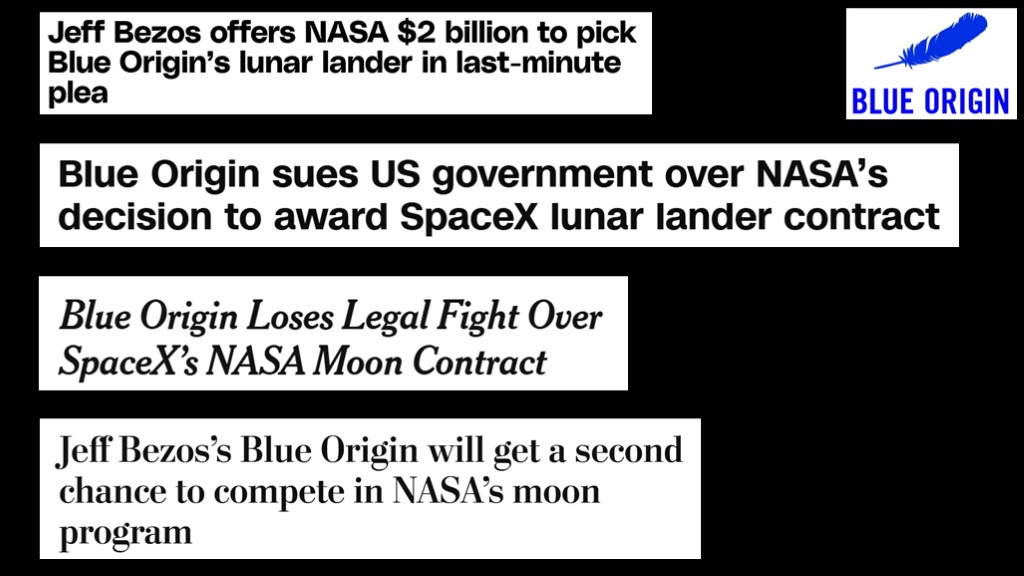
After they lost the bid for the lander program to SpaceX, Blue Origin first offered NASA an extra $2 billion to reverse their decision, sued the government over the decision, lost their suit, and then successfully lobbied for a second program, and the Blue Origin team won that bid.
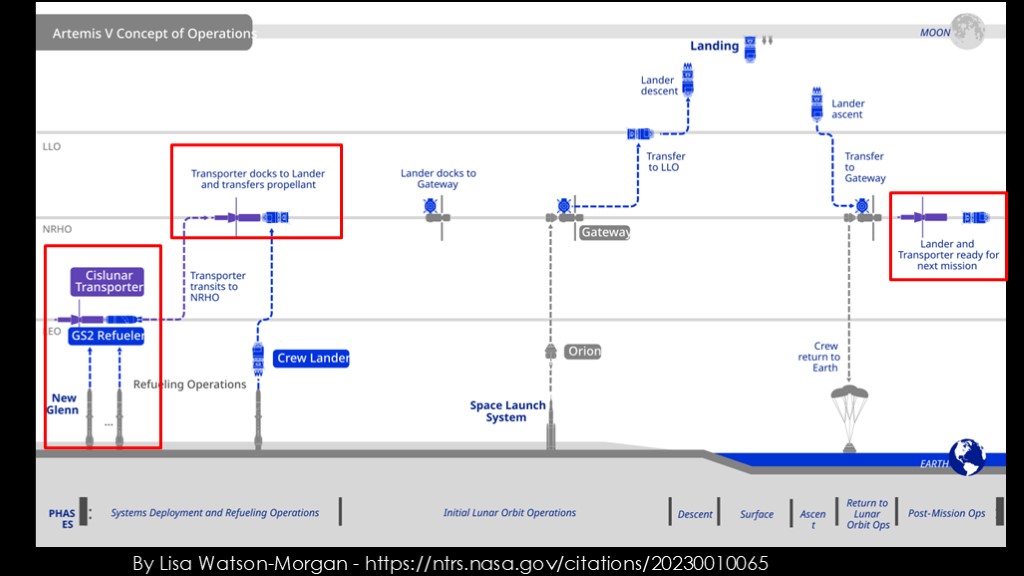
Humorously, the architecture that blue origin is planning requires not only refueling in earth orbit, but also a second refueling operation in lunar orbit. It *does* provide for possible reuse of the lander in the future, at the cost of an architecture that is more complicated and higher risk.
Both the SpaceX and Blue Origin architectures require orbital refueling to do what they need to do.
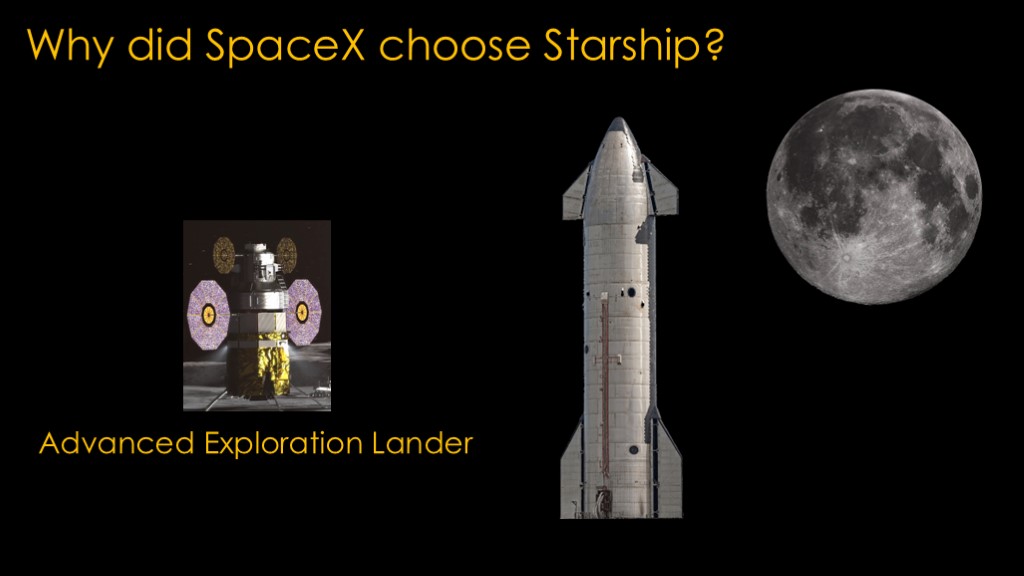
There is another good question about SpaceX's approach. Starship is a huge brute that will supposedly be able to carry 100+ tons into earth orbit.
Why not build a lander like NASA's advanced exploration lander - or Blue Origin's Blue Moon - launch it on starship, and send it to lunar orbit? Could SpaceX do that?
I think the answer is a pretty clearly yes. It would require developing a custom lander and a custom kick stage to it to the moon, and that would be fairly costly - likely more than SpaceX is getting paid on their current contract. The SpaceX HLS contract is $2.89 billion, which seems like a lot, but SpaceX is charging NASA $843 million to build a deorbit vehicle for ISS and the HLS lander is considerably more complicated than the deorbit vehicle.
Custom spacecraft are expensive, and custom spacecraft that carry humans are really expensive, and that approach doesn't align well with SpaceX's longer term goals.
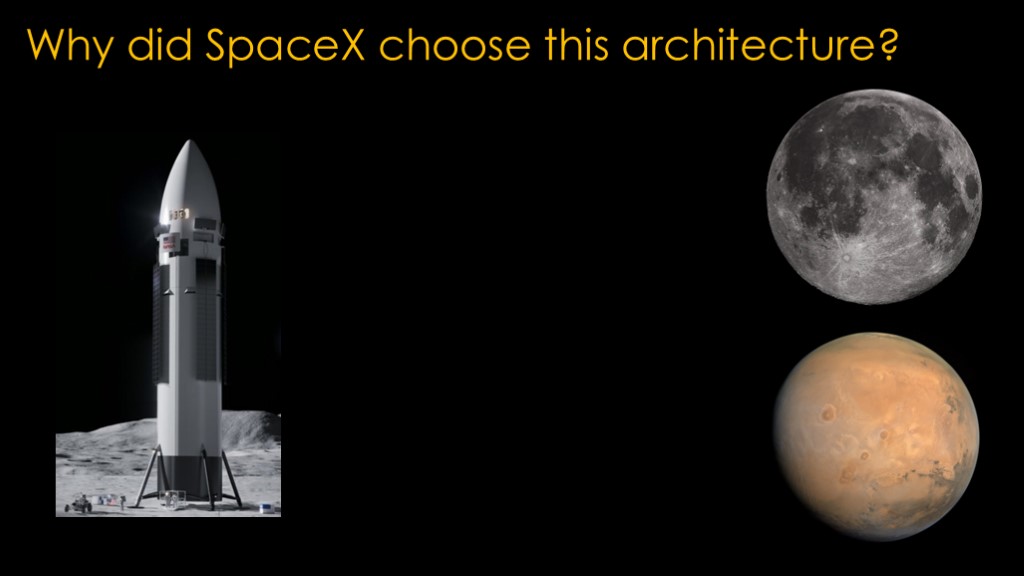
The only way HLS makes sense for SpaceX is to take a version of starship and modify it to be a "mega moon lander" that would work for NASA's mission and also push them along the same path they were already planning for missions to Mars.
That is why SpaceX chose to build a starship variant instead of doing something like Blue Moon, and the starship variant invariably requires more refueling flights. But it also can carry a *lot* more mass to the lunar surface.
Is their orbital refueling approach feasible?
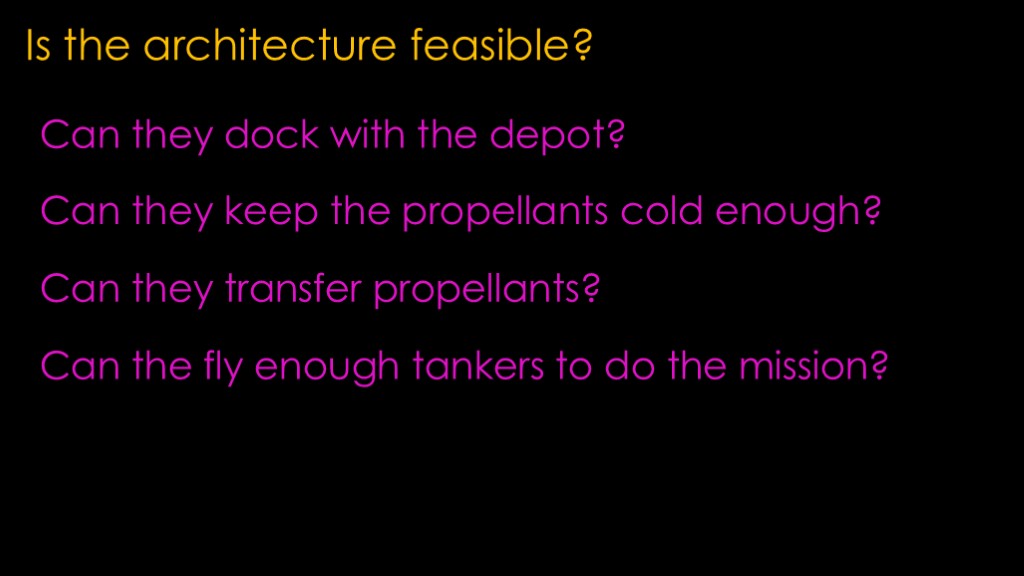
There are four questions to answer to determine the feasibility
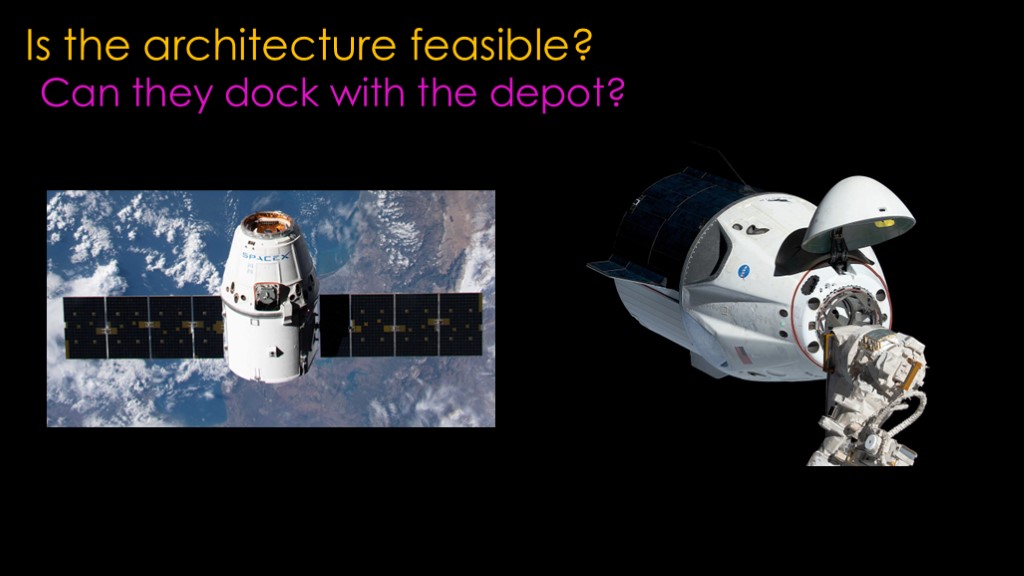
Can they dock with the depot?
This is the easiest one to answer. SpaceX has flown 30 resupply flights and 12 crewed flights to the ISS. Starship is bigger but they own both vehicles, and it's pretty clear that they can dock them together.
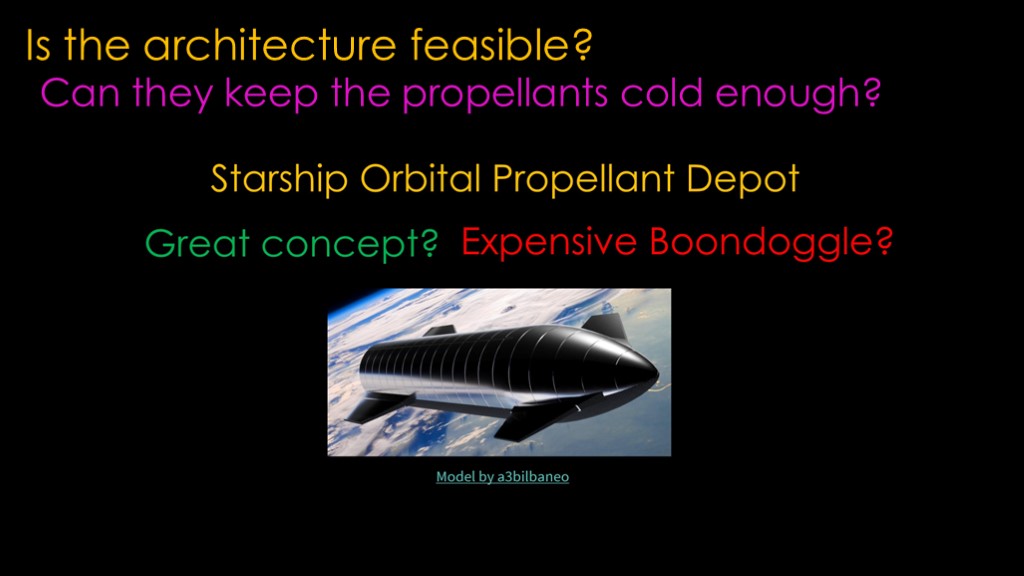
Can they keep propellants cool enough?
I did a talk on using starship as a propellant depot that you can find linked in the video description.
My basic conclusion was that it was possible to store propellant for fairly long durations using passive techniques, including appropriate surface coatings and controlled orientation.
Those aren't the only techniques.
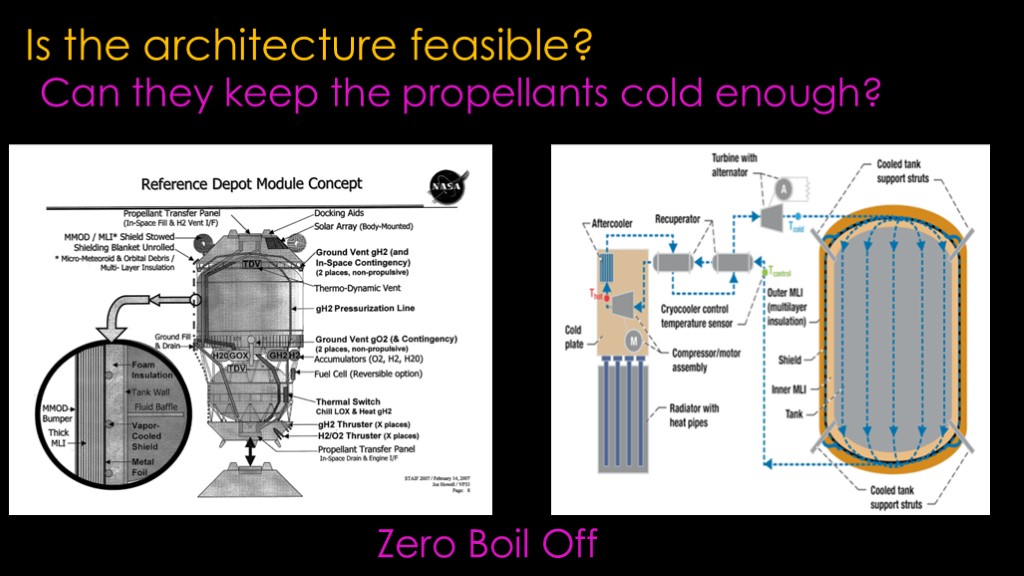
NASA has done a lot of development research on what is know as zero boil off technology. It uses a very specialized refrigerator known as a cryocooler that is used to keep the very cold propellants liquid.
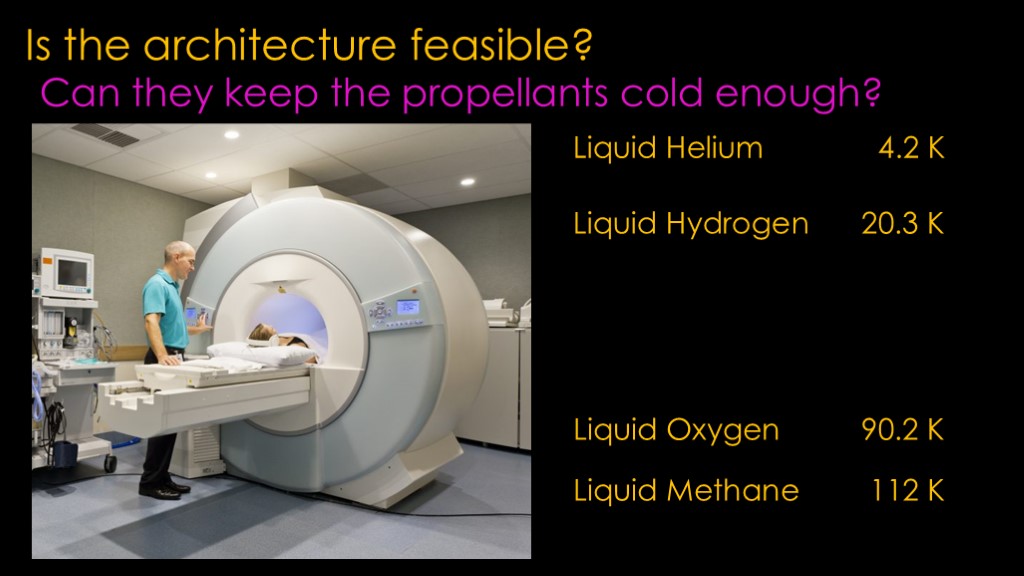
MRI scanners need liquid helium to keep their scanner coils superconducting, all the way down at a temperature of 4.2 kelvin, and they use cryocoolers to either reduce or eliminate the loss of the helium.
The NASA designs are typically targeting liquid hydrogen at 20.3 Kelvin.
Starship uses liquid oxygen and 90.2 kelvin at liquid methane at 112 kelvin. Even if SpaceX wants to subchill those propellants as they do before launch, it's very feasible to build a system that will result in zero boil-off storage of both propellants as they are *much* easier to deal with than liquid hydrogen or helium.
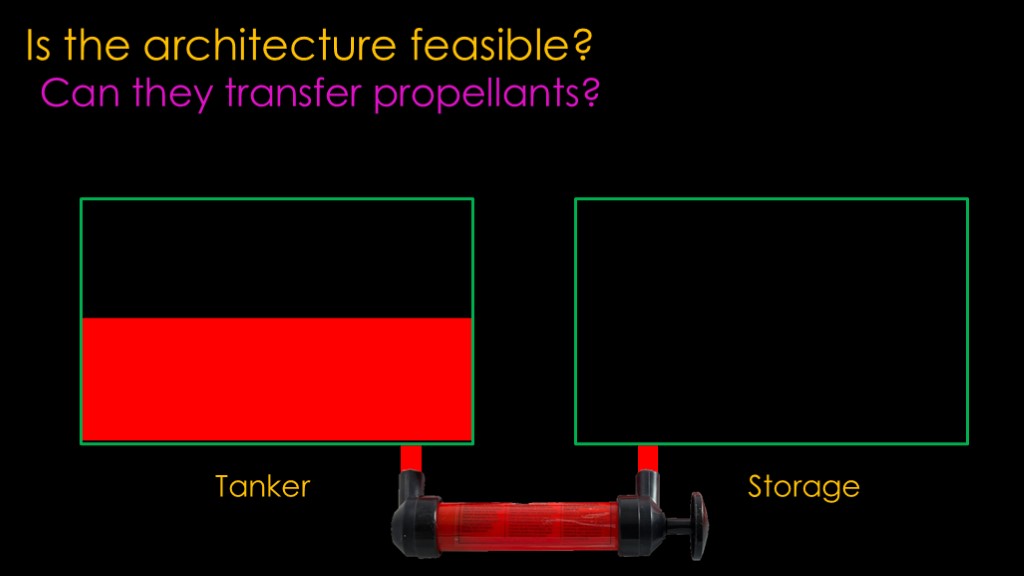
Can they transfer propellants?
On the earth, it's really easy. Just connect a pump between the tanker and the storage container, and pump the fluid into the storage tank.
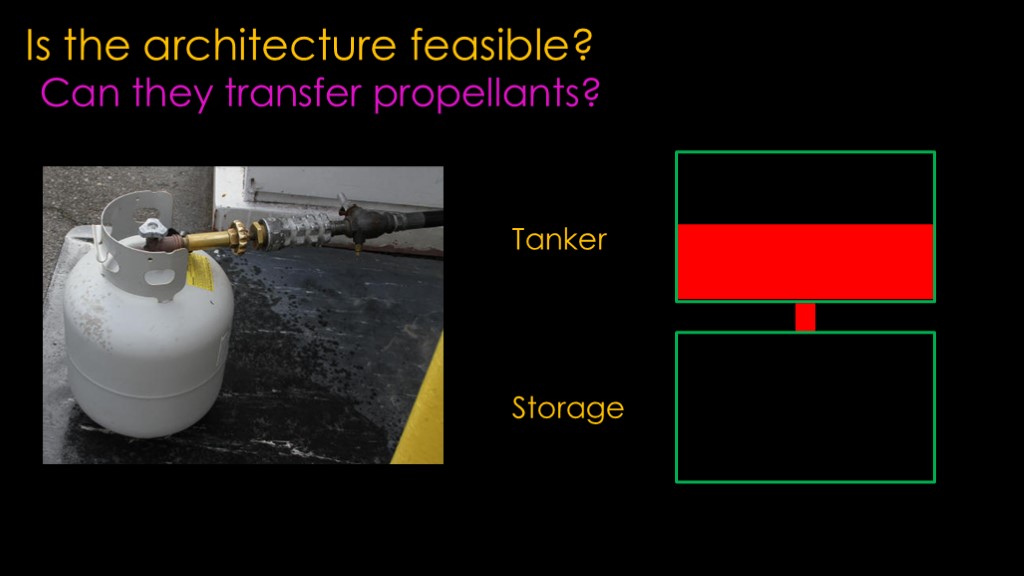
Or you can skip the pump and just put the tanker up higher and use gravity to make the transfer.
In either case you may need to do something with the vapor in the storage tank, as it will increase in pressure as the tank fills. If you've had a propane tank refilled, you will see the operator vent the propane vapor out to reduce the pressure.
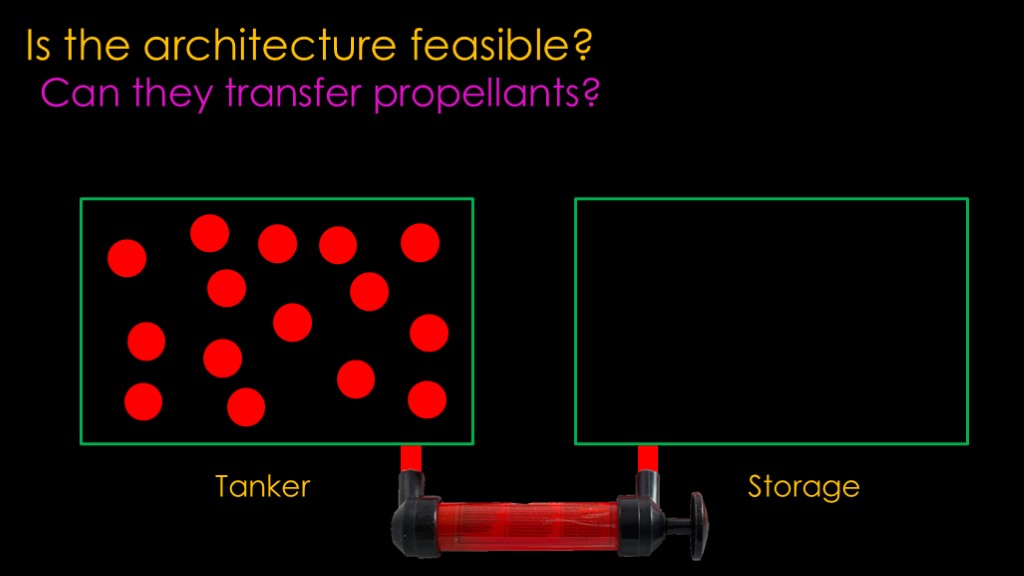
But space gives us a problem. There is no gravity to push the propellant against one side of the tank, so your pump is mostly trying to pump vapor. That's not good for the pump and it doesn't work very well.
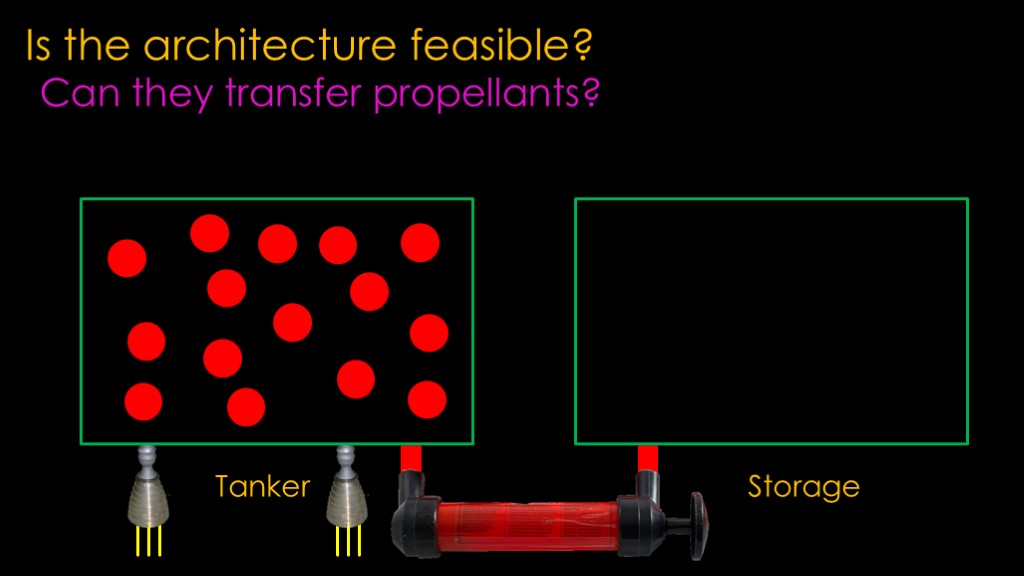
There's a simple way of dealing with this. You take a couple of small thrusters, put them at the bottom of the tank, and fire them. That pushes the tank up and the fluid down, setting it at the bottom so the pump can get it or it can flow into the tank "under" it.
These thrusters are typically known as "ullage" thrusters. Rocket stages in space that use cryogenic propellants use the same technique to get the propellant to the bottom of the tanks and therefore available for the engines to pump during a restart, so it's a very old technique and works fine.
The downside is the mass of the system, the mass of propellant it takes to create the thrust, and the fact that the thrust will change the orbit.
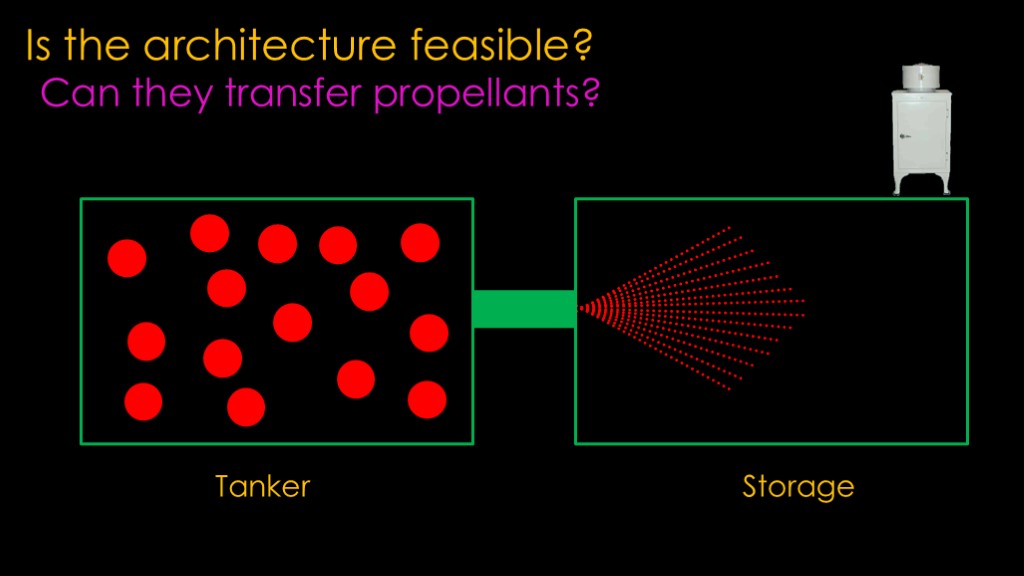
There's another approach that has been proposed.
You use a cryocooler to cool the storage system to a very cold temperature, subchilling the propellant and the tank walls. At subchilled temperatures there will be very little vapor in the storage tank and therefore very little pressure.
You then open a transfer pipe between the two tanks. The pressure in the tank then pushes the combined liquid/vapor mixture into the storage tank, spraying it in streams towards the tank walls. The tanks walls will then subchill the liquid and condense the vapor, keeping the temperature cold and allowing the propellant flow to continue.
NASA has gotten tanks 90% full using this technique, though not in orbit.
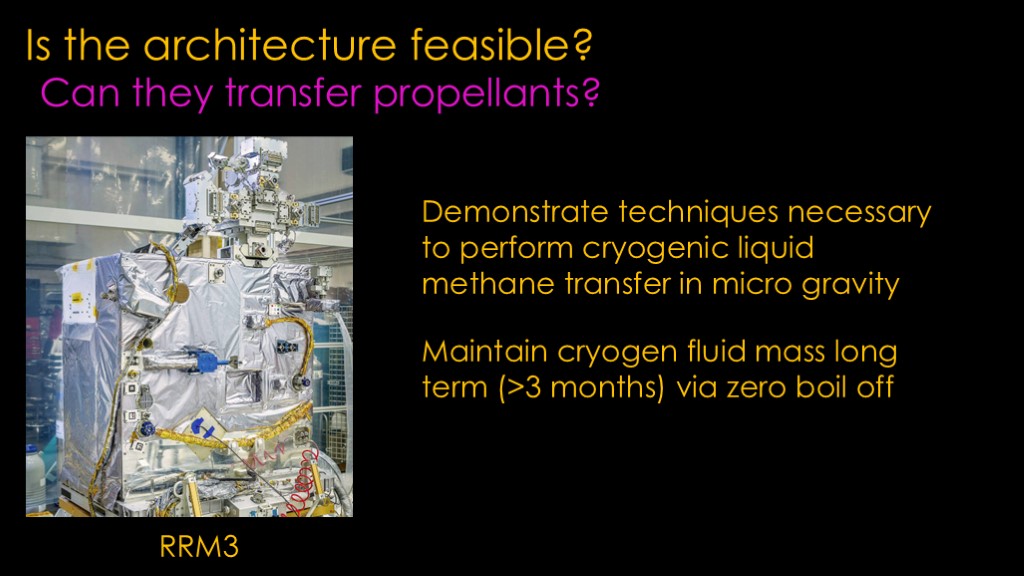
Speaking of orbit, NASA flew a mission known as RRM3 - robotic refueling mission 3 - to the ISS in 2018
It had two primary goals.
It achieved the second goal for 4 months, but the cryocooler failed and the methane had to be vented away, so the first goal was never attempted.
The thermodynamic approach seems elegant if you already have a cryocooler on your depot, but the ullage approach is more proven and quicker and that's what I expect SpaceX to choose. Or maybe they'll do both. Either way, there are workable solutions to propellant transfer.
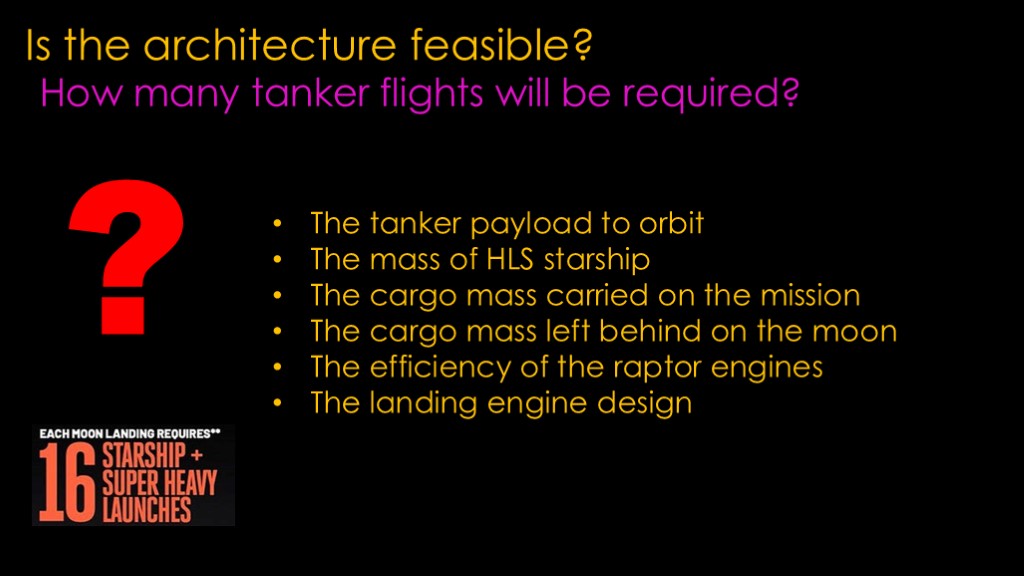
The technology for the architecture is feasible, so the remaining question is around the number of tanker flights to support an HLS or a Mars mission.
And the magic number is... (drum roll)
Yeah, I don't know...
There seems to be a belief that this is a really important question, perhaps fueled by the early blue origin PR stating/complaining/whining that it would take 16 flights. Lots of discussions or fights about whether the number is 8 or 12 or 20 or whatever.
The actual number depends on a lot of factors. Among them are.
The tanker payload to orbit.
The mass of HLS starship
The cargo mass carried on the mission
The cargo mass left behind on the moon
The efficiency of the raptor engines
The landing engine design
I don't think I know *any* of those factors, and I think there are factors there that even SpaceX doesn't know right now...
But I also think the number doesn't really matter.
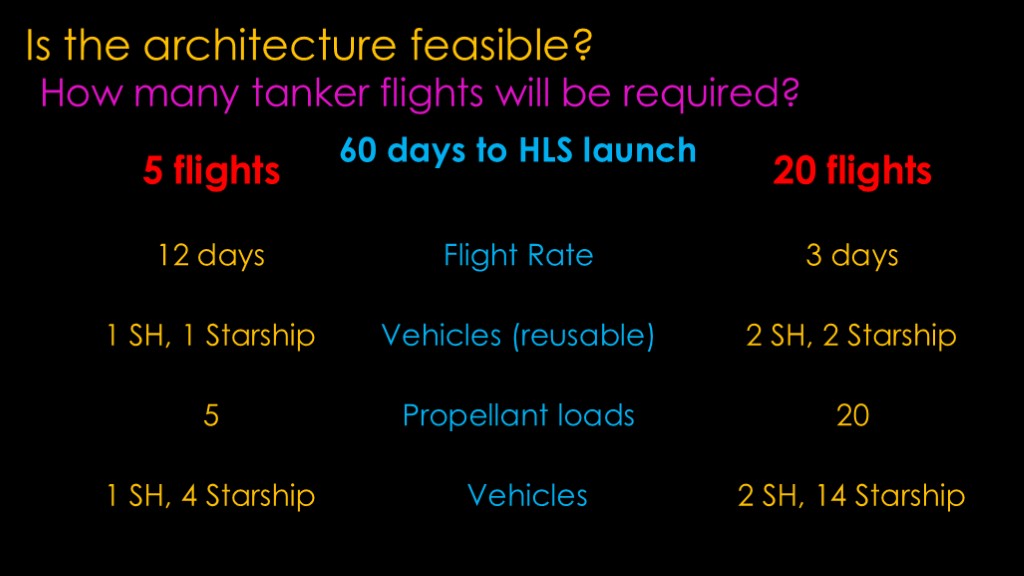
Let's say that we have an HLS launch scheduled 60 days from now and we have to complete the refueling in that time period. 60 days is easily done with current propellant depot technologies.
We'll look at two scenarios, one with an architecture that requires 5 tanker flights, and another with an architecture that requires 20 flights. The real number of flights is probably between those two numbers.
We fly once every 12 days for the first option, once every 3 days for the second one.
The target for starship and super heavy is rapid reuse, so flying every 12 days seems simple enough to do. The same pair should be able to fly once every three days, but let's just allocate 2 super heavy and starship vehicles so they can fly once every 6 days.
Neither of these look very challenging.
We also have to use a lot more propellant in the 20 flight version, but propellant is cheap.
The whole point of the starship architecture is that flights are cheap, and I would therefore submit that there's no reason to suspect that 20 flights is a lot harder than 5 flights. If you can do 5 flights, you can do 20 - you just need to turn the crank a few more times.
SpaceX flew 8 Falcon 9 flights from SLC-40 in the first 60 days of 2024, and that's with a vehicle that is less reusable than starship. 20 flights in 60 days should not be a significant challenge for Starship.
If starship isn't reusable, my estimates are that 5 flights becomes 4 and 20 becomes 14 because of the larger payload capacity of an expendable starship.
14 is obviously a lot more than 2 and that will definitely affect the economics, but SpaceX flew 19 Falcon 9 flights in the first 60 days of 2024, and every one of those had an expendable second stage. Non-reusable second stages would break the Mars scenario but probably aren't a problem for 3 lunar flights.
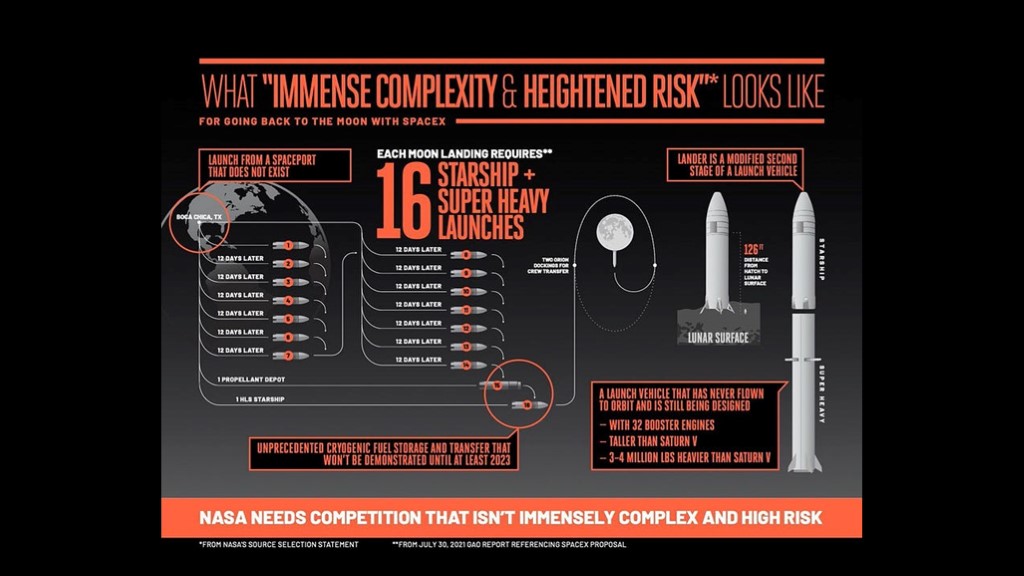
And that's what's going on. This has never been anything substantial behind the concerns about the architecture and especially about the exact number of launches, so don't worry about the exact number.
If starship is fully reusable, it doesn't matter, and if starship isn't fully reusable, SpaceX needs to make it fully reusable because both Starlink and Mars are relying on the reuse.

If you enjoyed this video, it's been hot in Seattle.